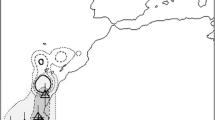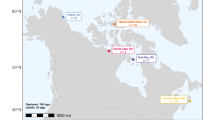Abstract
In 1989, 313 foraging flights of common terns in the Wadden Sea were radio-tracked. The feeding trips lasted on average 115 min covering about 30 km per flight. Completely tracked flights had a mean radius of 6.3 km. The terns preferred distinct foraging areas in the Wadden Sea. These were visited at site-specific phases of the tidal cycle resulting in a temporal and spatial pattern of foraging, caused by the site-specific and tide-related fluctuations of food availability.
Similar content being viewed by others
References
Bauer K (1965) Zur Nahrungsökologie einer binnenländischen Population der Flußseeschwalbe (Sterna hirundo). Egretta 8: 35–51
Becker PH, Finck P (1985) Witterung und Ernährungssituation als entscheidende Faktoren des Bruterfolgs der Flußseeschwalbe (Sterna hirundo). J Ornithol 126:393–404
Becker PH, Frank D (1990) Kontinuierliche Wägung brütender Seevögel zur Analyse der Ernährungssituation. In: Van den Elzen R, Schuchmann K-L, Schmidt-Koenig K (eds) Current Topics in Avian Biology. Proc. Int. 100. DO-G Meeting Bonn 1988: 173–179
Becker PH, Specht R (1991) Body mass fluctuations and mortality in Common Tern Sterna hirundo chicks dependent on weather and tide in the Wadden Sea. Ardea 79: 45–56
Becker PH, Baum I, Marsh S-L (1991a) Warum wechseln Flußseeschwalben zwischen Nahrungsquellen im Wattenmeer und Binnenland? Verh Dtsch Zool Ges 84: 299–300
Becker PH, Frank D, Sudmann SR, Wagener M (1991b) Funkpeilung von Flußseeschwalben (Sterna hirundo) bei der Nahrungssuche im Wattenmeer. Seevögel 12: 52–61
Boecker M (1967) Vergleichende Untersuchungen zur Nahrungsund Nistökologie der Flußseeschwalbe und der Küstenseeschwalbe. Bonn Zool Beitr 18: 15–126
Drent RH (1970) Functional aspects of incubation in the Herring Gull. In: Baerends GP, Drent RH (eds): The Herring Gull and its egg. Behaviour Suppl 17, pp 1–132
Duffy DC (1986) Foraging at patches: interactions between Common and Roseate Terns. Ornis Scand 17: 47–52
Dunn EK (1972) Studies on terns with particular reference to feeding ecology. D Phil thesis, University of Durham
Erwin RM (1977) Foraging and breeding adaptations to different food regimes in three seabirds: the Common Tern, Sterna hirundo, Royal Tern, Sterna maxima, and Black Skimmer, Rynchops niger. Ecology 58: 389–397
Frank D (1990) Fütterrate und Nahrungszusammensetzung von Flußseeschwalben (Sterna hirundo) anhand automatischer Registrierung am Nest. In: Van den Elzen R, Schuchmann K-L, Schmidt-Koenig K (eds) Current Topics in Avian Biology. Proc Int 100. DO-G Meeting Bonn 1988: 159–165
Frank D (1992) The influence of feeding conditions on food provisioning of chicks in Common Terns Sterna hirundo nesting in the German Wadden Sea. Ardea 80: 45–55
Frank D, Becker PH (1992) Body mass and nest reliefs in Common Terns Sterna hirundo exposed to different feeding conditions. Ardea 80: 57–69
Glasmacher M (1987) Nisthilfen für eine niederrheinische Flußseeschwalbenpopulation (Sterna hirundo). Charadrius 23: 183–199
Gorke M (1990) Die Lachmöwe (Larus ridibundus) in Wattenmeer und Binnenland. Seevögel 11: 1–48
Kacelnik A, Krebs JR (1985) Learning to exploit patchily distributed food. In: Sibly RM, Smith RH (eds) Behavioural Ecology. Blackwell, Oxford, pp 189–205
Klaassen M, Becker PH, Wagener M (1992) Transmitter loads do not affect the daily energy expenditure of nesting Common Terns. J Field Ornithol 63: 181–185
Massias A, Becker PH (1990) Nutritive value of food and growth in Common Tern (Sterna hirundo) chicks. Ornis Scand 21: 187–194
McNicholl MK (1975) Larid site tenacity and group adherence in relation to habitat. Auk 92: 98–104
Mes R, Schuckard R (1976) Een onderzoek naar verschillen in fourageeraktiviteit tussen Visdief Sterna hirundo en Noordse Stern Sterna paradisaea op de Engelsmanplaat (NL). (Report Nr. 11) Verslagen en Technische Gegevens Inst voor Taxon Zool, Amsterdam
Mes R, Schuckard R, Wattel J (1978) Visdieven Sterna hirundo zoeken koelte. Limosa 51: 64–68
Morris RD (1986) Seasonal differences in courtship feeding rates of male common terns. Can J Zool 64: 501–507
Nisbet ICT (1983) Territorial feeding by Common Terns. Colonial Waterbirds 6: 64–70
Nisbet ICT, Winchell JM, Heise AE (1984) Influence of age on the breeding biology of Common Terns. Colonial Waterbirds 7: 117–126
Noordhuis R, Spaans AL (1992) Interspecific competition for food between Herring Larus argentatus and Lesser Black-backed Gulls L. fuscus in the Dutch Wadden Sea area. Ardea 80: 115–132
Pearson TH (1968) The feeding biology of sea-bird species breeding on the Farne Islands, Northumberland. J Anim Ecol 37: 521–552
Pennycuick CJ (1989) Bird flight performance. Oxford University Press
Pierotti R, Annett C (1987) Reproductive consequences of dietary specialization and switching in an ecological generalist. In: Kamil AC, Krebs JR, Pulliam HR (eds) Foraging behavior. Plenum Press, New York London, pp 417–442
Sudmann SR, Becker PH (1992) Zeitaufwand für die Nahrungssuche von Flußseeschwalben (Sterna hirundo) während der Brut-und Huderphase. J Ornithol 133: 437–442
Veen J (1977) Functional and causal aspects of nest distribution in colonies of the Sandwich Tern (Sterna s. sandvicensis Lath.). Behaviour Suppl 20: 1–193
Author information
Authors and Affiliations
Additional information
Supported by the Deutsche Forschungsgemeinschaft
Rights and permissions
About this article
Cite this article
Becker, P.H., Frank, D. & Sudmann, S.R. Temporal and spatial pattern of common tern (Sterna hirundo) foraging in the Wadden Sea. Oecologia 93, 389–393 (1993). https://doi.org/10.1007/BF00317883
Received:
Accepted:
Issue Date:
DOI: https://doi.org/10.1007/BF00317883




